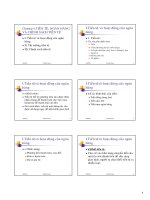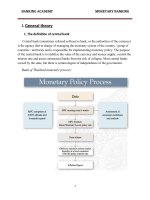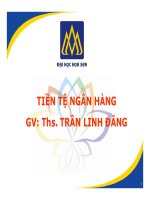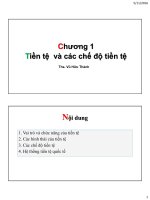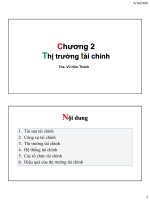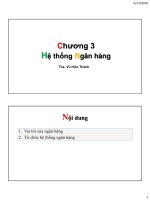Bài giảng tiền tệ, ngân hàng và thị trường tài chính 2 chương 3 quản trị rủi ro các định chế tài chính
Bạn đang xem bản rút gọn của tài liệu. Xem và tải ngay bản đầy đủ của tài liệu tại đây (891.83 KB, 34 trang )
<span class="text_page_counter">Trang 1</span><div class="page_container" data-page="1">
FINANCE - MONETARY DEPARTMENT
</div><span class="text_page_counter">Trang 2</span><div class="page_container" data-page="2">CHUẨN ĐẦU RA
1. Phân biệt các loại rủi ro của định chế tài chính
2. Giải thích các biện pháp quản trị rủi ro cơ bản.
Sau khi hoàn thành chương này, Người học có thể:
LEARNING OUTCOMES
<small>Upon completion of this chapter, learners will be able to:1.Distinguishing among risks of financial institutions2. Explaining basic risk management methods</small>
</div><span class="text_page_counter">Trang 3</span><div class="page_container" data-page="3">Tiền gửi giao dịch Tiền gửi phi giao dịch
</div><span class="text_page_counter">Trang 4</span><div class="page_container" data-page="4">Cash items in process of collection Deposits at other banks
Tiền trong quá trình thu Tiền gửi tại ngân hàng khác
</div><span class="text_page_counter">Trang 5</span><div class="page_container" data-page="5">Nguyên tắc cơ bản: Nhận tiền gửi từ tiền mặt
Khi khách hàng mở tài khoản tiền gửi thanh toán, dự trữ của ngân hàng tăng lên bằng đúng với lượng tiền gửi tăng thêm.
<small>First National BankFirst National BankTài sảnNguồn vốnTài sảnNguồn vốn</small>
Opening of a checking account leads to an increase in the bank’s reserves equal to the increase in checkable deposits
<small>First National BankFirst National BankAssetsLiabilitiesAssetsLiabilities</small>
</div><span class="text_page_counter">Trang 6</span><div class="page_container" data-page="6">Nguyên tắc cơ bản: Nhận tiền gửi chuyển khoản
<small>First National BankSecond National BankTài sảnNguồn vốnTài sảnNguồn vốn</small>
Khi ngân hàng nhận thêm tiền gửi, dự trữ của ngân hàng tăng lên đúng bằng lượng tiền gửi tăng thêm, khi tiền gửi của ngân hàng giảm, dự trữ của ngân hàng giảm tương ứng
Basic Banking: Check Deposit
<small>First National BankSecond National BankAssetsLiabilitiesAssetsLiabilities</small>
When a bank receives additional deposits, it gains an equal amount of reserves, when it loses deposits, it loses an equal amount of reserves.
</div><span class="text_page_counter">Trang 7</span><div class="page_container" data-page="7">Ngun tắc cơ bản: tìm kiếm lợi nhuận
<small>PART</small><small>• Chuyển đổi tài sản: bán các khoản nợ phải trả với các đặc điểm riêng và sử dụngsố vốn có được để mua tài sản có đặc điểm khác</small>
<small>• Ngân hàng đi vay ngắn hạn và cho vay dài hạn</small>
<small>First National BankFirst National BankTài sảnNguồn vốnTài sảnNguồn vốn</small>
<small>• Asset transformation: selling liabilities with one set of characteristics and using the proceeds to buy assets with a different set of characteristics</small>
<small>• The bank borrows short and lends long</small>
<small>First National BankFirst National BankAssetsLiabilitiesAssetsLiabilities</small>
</div><span class="text_page_counter">Trang 8</span><div class="page_container" data-page="8">Nguyên tắc chung của quản trị ngân hàng
</div><span class="text_page_counter">Trang 9</span><div class="page_container" data-page="9">Quản trị thanh khoản: Dự trữ vượt mức dồi dào
• Giả sử dự trữ bắt buộc là 10%
• Nếu ngân hàng có dự trữ vượt mức dồi dào, dịng tiền gửi rút ra khơng làm thay đổi các khoản mục của bảng cân đối.
<small>Tài sảnNguồn vốnTài sảnNguồn vốnDự trữ$20M Tiền gửi$100MDự trữ$10M Tiền gửi$90M</small>
• Suppose bank’s required reserves are 10%
• If a bank has ample excess reserves, a deposit outflow does not necessitate changes in other parts of its balance sheet
<small>AssetsLiabilitiesAssetsLiabilitiesReserves$20M Deposits$100MReserves$10M Deposits$90MLoans$80M Bank </small>
<small>$10MLoans$80M Bank Capital$10MSecurities$10MSecurities$10M</small>
</div><span class="text_page_counter">Trang 10</span><div class="page_container" data-page="10">Quản trị thanh khoản: Thiếu hụt dự trữ vượt mức
• Dự trữ là một yêu cầu mang tính pháp lý và sự thiếu hụt dự trữ phải được giải quyết
• Dự trữ vượt mức được xem là một sự đảm bảo giúp hạn chế các chi phí phát sinh liên quan đến dòng tiền gửi rút ra.
<small>Tài sảnNguồn vốnTài sảnNguồn vốnDự trữ$10M Tiền gửi$100MDự trữ$0 Tiền gửi$90M</small>
<small>AssetsLiabilitiesAssetsLiabilitiesReserves$10M Deposits$100MReserves$0 Deposits$90MLoans$90M Bank </small>
<small>$10MLoans$90M Bank Capital$10MSecurities$10MSecurities$10M</small>
</div><span class="text_page_counter">Trang 11</span><div class="page_container" data-page="11">Quản trị thanh khoản: Đi vay
</div><span class="text_page_counter">Trang 12</span><div class="page_container" data-page="12">Quản trị thanh khoản: Bán chứng khoán
</div><span class="text_page_counter">Trang 13</span><div class="page_container" data-page="13">Quản trị thanh khoản: Vay quỹ liên bang
Borrowing from the Fed also incurs interest payments based on the discount rate
</div><span class="text_page_counter">Trang 14</span><div class="page_container" data-page="14">Quản trị thanh khoản: Giảm cho vay
<small>PART</small>• Giảm các khoản cho vay là cách thức xử lý gây tốn kém nhất để bổ sung dự trữ
• Thu hồi các khoản cho vay có thể tạo phản ứng với khách hàng • Các ngân hàng khác chỉ đồng ý mua lại các khoản cho vay với mức
• Reduction of loans is the most costly way of acquiring reserves • Calling in loans antagonizes customers
• Other banks may only agree to purchase loans at a substantial
</div><span class="text_page_counter">Trang 15</span><div class="page_container" data-page="15">Quản trị tài sản: ba mục tiêu
</div><span class="text_page_counter">Trang 16</span><div class="page_container" data-page="16">Quản trị tài sản: Bốn cơng cụ
<small>PART</small>1. Tìm người đi vay trả lãi suất cao và có khả năng vỡ nợ thấp 2. Mua chứng khoán với lợi nhuận cao và rủi ro thấp
3. Giảm rủi ro bằng cách đa dạng hóa
4. Cân bằng nhu cầu thanh khoản trong tương quan với việc gia tăng lợi nhuận từ đầu tư tài sản kém thanh khoản.
2. Purchase securities with high returns and low risk 3. Lower risk by diversifying
4. Balance need for liquidity against increased returns from less liquid assets
</div><span class="text_page_counter">Trang 17</span><div class="page_container" data-page="17">Quản trị nợ
Mở rộng thị trường cho vay qua đêm và các cơng cụ tài chính mới (như chứng chỉ tiền gửi có thể chuyển nhượng)
Mức độ quan trọng của tiền gửi giao dịch giảm
Liability Management
Recent phenomenon due to rise of money center banks
Expansion of overnight loan markets and new financial instruments (such as negotiable CDs)
Checkable deposits have decreased in importance as source of bank funds
</div><span class="text_page_counter">Trang 18</span><div class="page_container" data-page="18">Quản trị mức đủ vốn
Vốn chủ sở hữu giúp ngân hàng ngăn chặn sự sụp đổ
Số vốn chủ sở hữu có tác động đến thu nhập của các chủ sở hữu Yêu cầu mang tính pháp lý
Capital Adequacy Management
Bank capital helps prevent bank failure
The amount of capital affects return for the owners (equity holders) of the bank
Regulatory requirement
</div><span class="text_page_counter">Trang 19</span><div class="page_container" data-page="19">Quản trị mức đủ vốn: ngăn chặn sụp đổ ngân hàng
<small>PART</small><small>Ngân hàng có vốn chủ sở hữu lớnNgân hàng có ít vốn chủ sở hữuTài sảnNguồn vốnTài sảnNguồn vốnDự trữ$10M Tiền gửi$90M Dự trữ$10M Tiền gửi$96MCho vay$90M Vốn CSH$10M Cho vay$90M Vốn CSH$4M</small>
<small>High Bank CapitalLow Bank CapitalTài sảnNguồn vốnAssetsLiabilitiesDự trữ$10M Tiền gửi$90M Dự trữ$10M Tiền gửi$96MCho vay$85M Vốn CSH$5M Cho vay$85M Vốn CSH-$1M</small>
Capital Adequacy Management: Preventing Bank Failure
<small>High Bank CapitalLow Bank CapitalAssetsLiabilitiesAssetsLiabilitiesReserves$10M Deposits$90M Reserves$10M Deposits$96MLoans$90M Bank Capital$10M Loans$90M Bank Capital$4M</small>
<small>High Bank CapitalLow Bank CapitalAssetsLiabilitiesAssetsLiabilitiesReserves$10M Deposits$90M Reserves$10M Deposits$96MLoans$85M Bank Capital$5M Loans$85M Bank Capital-$1M</small>
</div><span class="text_page_counter">Trang 20</span><div class="page_container" data-page="20">Quản trị mức đủ vốn: tỷ lệ lợi nhuận sau thuế trên vốn chủ sở hữu
<small>ROA = </small> <sup>Lợi nhuận sau thuế</sup> <small>Tổng tài sản</small>
ROA: return on assets – lợi nhuận sau thuế trên tổng tài sản
ROE: return on equity – lợi nhuận sau thuế trên vốn chủ sở hữu ROE = <sup>Lợi nhuận sau thuế</sup>
Vốn chủ sở hữu
Mối quan hệ giữa ROA và ROE được thể hiện thông qua số nhân vốn chủ sở hữu, là tỷ lệ giữa tổng tài sản và vốn chủ sở hữu
Capital Adequacy Management: Returns to Equity Holders
<small>ROA = </small> <sup>net profit after taxes</sup> <small>assets</small>
ROA: return on assets - net profit after taxes per dollar of assets
ROE: return on equity – net profit after taxes per dollar of equity capital
ROE = <sup>net profit after taxes </sup> equity capital
Relationship before ROA and ROE is expressed by the Equity multiplier: the amount of assets per dollar of equity capital
EM = <sup>Assets</sup> Equity capital
net profit after taxes net profit after taxes assets
</div><span class="text_page_counter">Trang 21</span><div class="page_container" data-page="21">Quản trị mức đủ vốn: Sự an tồn
<small>PART</small>• Mang lại lợi ích cho các chủ sở hữu ngân hàng do nó đảm bảo an tồn cho khoản đầu tư của họ.
• Gây tốn kém cho chủ sở hữu ngân hàng do vốn ngân hàng càng cao thì tỷ lệ lợi nhuận sau thuế trên vốn chủ
• Costly to owners of a bank because the higher the bank capital, the lower the return on equity
• Choice depends on the state of the economy and levels of confidence
</div><span class="text_page_counter">Trang 22</span><div class="page_container" data-page="22">Áp dụng:
<small>PART</small>Khủng hoảng vốn gây ra khủng hoảng tín dụng trong cuộc khủng hoảng tài chính tồn cầu:
• Sự suy giảm của vốn chủ sở hữu dẫn đến tăng trưởng tín dụng chậm hơn
Các ngân hàng bị thiệt hại lớn từ việc nắm giữ chứng khoán được đảm bảo các khoản cho vay thế chấp nhà ở.
Các khoản thua lỗ làm giảm vốn chủ sở hữu ngân hàng
• Các ngân hàng không thể huy động nhiều vốn trong bối cảnh nền kinh tế yếu kém, phải thắt chặt các tiêu chuẩn cho vay và giảm cho vay.
Application:
<small>PART</small>How a Capital Crunch Caused a Credit Crunch During the Global Financial Crisis:
• Shortfalls of bank capital led to slower credit growth
Huge losses for banks from their holdings of securities backed by residential mortgages.
Losses reduced bank capital
• Banks could not raise much capital on a weak economy, and had to tighten their lending standards and reduce lending.
</div><span class="text_page_counter">Trang 23</span><div class="page_container" data-page="23">• Chun mơn hóa trong cho vay
• Sàng lọc và tuân thủ chặt chẽ các điều khoản
</div><span class="text_page_counter">Trang 24</span><div class="page_container" data-page="24">Quản trị rủi ro tín dụng
•Mối quan hệ dài hạn với khách hàng
•Cam kết cho vay
</div><span class="text_page_counter">Trang 25</span><div class="page_container" data-page="25">Quản trị rủi ro lãi suất
Nếu ngân hàng có nợ nhạy lãi lớn hơn tài sản nhạy lãi, khi lãi suất tăng sẽ làm giảm lợi nhuận và ngược lại, khi lãi suất giảm sẽ làm tăng lợi nhuận của ngân hàng
<small>First National Bank</small>
<small>Tài sảnNguồn vốn</small>
<small>Tài sản nhạy lãi$20M Nợ nhạy lãi$50MCho vay lãi suất thả nổi và cho vay ngắn hạnChứng chỉ tiền gửi lãi suất thả nổiChứng khoán ngắn hạnTiền gửi thị trường tiền tệ</small>
<small>Tài sản có lãi suất cố định$80M Nguồn vốn có lãi suất cố định$50MDự trữTiền gửi thanh toán</small>
<small>Cho vay dài hạnTiền gửi tiết kiệmChứng khoán dài hạnChứng chỉ tiền gửi dài hạn</small>
<small>Rate-sensitive assets$20M Rate-sensitive liabilities$50MVariable-rate and short-term loansVariable-rate CDs</small>
<small>Short-term securitiesMoney market deposit accountsFixed-rate assets$80M Fixed-rate liabilities$50M</small>
<small>ReservesCheckable depositsLong-term loansSavings depositsLong-term securitiesLong-term CDs</small>
<small>Equity capital</small>
</div><span class="text_page_counter">Trang 26</span><div class="page_container" data-page="26">Phân tích độ lệch (Gap) và thời lượng (Duration) Analysis
• Độ lệch cơ bản:
<small>(Tài sản nhạy lãi - nợ nhạy lãi) x Δ lãi suất = Δ Lợi nhuận của ngân hàng</small>
• Phương pháp tiếp cận thời gian đáo hạn
Đo lường độ lệch cho các khoảng thời gian đáo hạn
• Basic gap analysis:
<small>(rate sensitive assets - rate sensitive liabilities) x Δ interest rates = Δ in bank profit</small>
• Maturity bucked approach
Measures the gap for several maturity subintervals.
• Standardized gap analysis
Accounts for different degrees of rate sensitivity.
</div><span class="text_page_counter">Trang 27</span><div class="page_container" data-page="27">Phân tích độ lệch và thời lượng
• % Δ giá trị thị trường chứng khoán - điểm phần trăm Δ lãi suất x thời lượng tính theo năm.
• Sử dụng thời lượng trung bình có trọng số của tài sản và nợ để xác định sự thay đổi giá trị rịng của trung gian tài chính khi lãi suất thay đổi
Gap and Duration Analysis
• % Δ in market value of security - percentage point Δ in interest rate x duration in years.
• Uses the weighted average duration of a financial
institution’s assets and of its liabilities to see how net worth responds to a change in interest rates.
</div><span class="text_page_counter">Trang 28</span><div class="page_container" data-page="28">Các hoạt động ngoại bảng
• Bán các khoản cho vay (tham gia cho vay dự phần thứ cấp) • Tạo ra các khoản thu nhập từ phí. Ví dụ:
Cung cấp dịch vụ chứng khốn có đảm bảo bằng cho vay thế chấp Tạo ra các SIV (cơng cụ đầu tư cấu trúc), có thể khiến các ngân
hàng gặp rủi ro, như đã xảy ra trong cuộc khủng hoảng tài chính
• Loan sales (secondary loan participation) • Generation of fee income. Examples:
Servicing mortgage-backed securities
Creating SIVs (structured investment vehicles) which can potentially expose banks to risk, as it happened in the global financial crisis
</div><span class="text_page_counter">Trang 29</span><div class="page_container" data-page="29">Các hoạt động ngoại bảng
• Phương thức quản trị hoạt động kinh doanh chứng khoán và quản trị rủi ro
• Hợp đồng tương lai, quyền chọn đối với cơng cụ nợ, hốn đổi lãi suất, giao dịch ngoại hối và đầu cơ. • Phát sinh vấn đề đại diện
Off-Balance-Sheet Activities
• Trading activities and risk management techniques • Financial futures, options for debt instruments, interest
rate swaps, transactions in the foreign exchange market and speculation.
• Principal-agent problem arises
</div><span class="text_page_counter">Trang 30</span><div class="page_container" data-page="30">Các hoạt động ngoại bảng
Kiểm soát nội bộ hạn chế vấn đề đại diện
• Tách bạch hoạt động kinh doanh và hạch tốn kế tốn • Giới hạn mức độ thua lỗ
• Giá trị chịu rủi ro
• Các thử nghiệm kiểm tra sức chịu đựng
Off-Balance-Sheet Activities
Internal controls to reduce the principal-agent problem
• Separation of trading activities and bookkeeping • Limits on exposure
• Value-at-risk • Stress testing
</div><span class="text_page_counter">Trang 31</span><div class="page_container" data-page="31">1. The risk stating the assets are sold at low price because of the sudden surge in withdrawals of liabilities is classified as: A. Payment risk
B. Liquidity risk C. Income risk D. Balance risk
1. Rủi ro khi tài sản được bán với giá thấp, phát sinh do sự gia tăng đột ngột trong việc rút tiền gửi được phân loại là:
A. Rủi ro mất khả năng thanh toán B. Rủi ro thanh khoản
C. Rủi ro thu nhập D. Rủi ro cân bằng
Multiple choice questions
2. Banks earn profits by selling ________ with attractive combinations of liquidity, risk, and return, and using the proceeds to buy ________ with a different set of characteristics.
A) loans; deposits B) securities; deposits C) liabilities; assets D) assets; liabilities
2. Ngân hàng tìm kiếm lợi nhuận bằng cách bán ____ với tính thanh khoản, mức độ rủi ro và thu nhập hấp dẫn, và sử dụng nó để mua _____ với đặc điểm khác biệt.
A) Cho vay, tiền gửi
Multiple choice questions
</div><span class="text_page_counter">Trang 32</span><div class="page_container" data-page="32">3. Default risk represents the likelihood that a borrower will evade his or her financial obligations with respect to interest, principal, or both.
A. True B. False
3. Rủi ro tín dụng được thể hiện qua khả năng người đi vay trốn tránh nghĩa vụ tài chính của mình bao gồm tiền lãi, tiền gốc hoặc cả hai.
A. Đúng B. Sai
Multiple choice questions
4. Of the following, which would be the first choice for a bank facing a reserve deficiency?
A) Call in loans
B) Borrow from the Fed C) Sell securities
D) Borrow from other banks
4. Đâu là lựa chọn đầu tiên của ngân hàng khi rơi vào tình trạng thiếu hụt dự trữ?
A) Thu hồi các khoản cho vay B) Vay của Fed
Multiple choice questions
</div><span class="text_page_counter">Trang 33</span><div class="page_container" data-page="33">5. Which of the following statements most accurately describes the task of bank asset management?
A) Banks seek the highest returns possible subject to minimizing risk and making adequate provisions for liquidity.
B) Banks seek to have the highest liquidity possible subject to earning a positive rate of return on their operations.
C) Banks seek to prevent bank failure at all cost; since a failed bank earns no profit, liquidity needs supersede the desire for profits.
D) Banks seek to acquire funds in the least costly way.
5. Điều nào sau đây mơ tả chính xác nhất nhiệm vụ của quản trị tài sản ngân hàng?
A) Các ngân hàng tìm kiếm lợi nhuận cao nhất phải tối thiểu hóa rủi ro và lập dự phịng thanh khoản đầy đủ.
B) Các ngân hàng đảm bảo thanh khoản cao nhất để đạt được tỷ suất sinh lợi dương C) Các ngân hàng tìm cách ngăn chặn sự sụp đổ bằng mọi giá; bởi nếu sụp đổ sẽ khơng có lợi nhuận, nhu cầu thanh khoản thay thế cho lợi nhuận mong muốn. D) Các ngân hàng tìm cách huy động vốn với cách thức ít tốn kém nhất.
Multiple choice questions
6. Which of the following has not resulted from more active liability management on the part of banks?
A) Increased bank holdings of cash items
B) Aggressive targeting of goals for asset growth by banks C) Increased use of negotiable CDs to raise funds
D) An increased proportion of bank assets held in loans
6. Điều nào sau đây không phải là kết quả của quản trị nợ chủ động của ngân hàng?
A) Ngân hàng tăng nắm giữ các khoản tiền mặt
B) Tích cực hướng đến mục tiêu tăng trưởng tài sản ngân hàng

